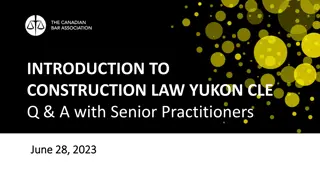Comprehensive Overview of Building Construction Techniques and Industry
Building construction encompasses the assembly and erection of structures for shelter, with a history rooted in human adaptation to various climates. The syllabus covers key topics such as foundations, roofs, masonry works, and more. Understanding the importance of perfect design, material selection, and quality control is crucial in achieving durable, economic buildings. The stages of construction involve considerations of function, economy, project details, and design aspects. The preparation of bills of quantities and specifications is essential, whether through bar charts or critical path methods. Construction projects can be tendered or done directly, catering to various sectors and services.
Uploaded on Nov 13, 2024 | 0 Views
Download Presentation

Please find below an Image/Link to download the presentation.
The content on the website is provided AS IS for your information and personal use only. It may not be sold, licensed, or shared on other websites without obtaining consent from the author.If you encounter any issues during the download, it is possible that the publisher has removed the file from their server.
You are allowed to download the files provided on this website for personal or commercial use, subject to the condition that they are used lawfully. All files are the property of their respective owners.
The content on the website is provided AS IS for your information and personal use only. It may not be sold, licensed, or shared on other websites without obtaining consent from the author.
E N D
Presentation Transcript
BUILDING CONSTRUCTION Instructor: Twana Instructor: Twana A. Hussein Twana.ahmad@ishik.edu.iq Twana.ahmad@ishik.edu.iq Civil Engineering Dept. Civil Engineering Dept. Tshik Tshik International University International University A. Hussein MSc . Structural Engineering MSc . Structural Engineering 1 11/13/2024
SYLLABUS: 1. Introduction 9. Beam and Columns 2. Types of buildings 10. Roofs 3. Earth work 11. Form and Scaffolding 4. Foundation 12. Damp proofing 5. Piles 13. Joints 6. Masonry works 14. Staircases 7. Arches 15. Trusses 8. Lintels 16. Floor and wall finishing 17. Precast units 2 11/13/2024
INTRODUCTION Building construction: the techniques and industry involved in the assembly and erection of structures, primarily those used to provide shelter. Building construction is an ancient human activity. It began with the purely functional need for a controlled environment to moderate the effects of climate. Constructed shelters were one means by which human beings were able to adapt themselves to a wide variety of climates and become a global species. it is the subject which describes the methods of using building materials in the construction of structure and satisfying strength, safety and economy. 3 11/13/2024
INTRODUCTION Any building will be acceptable if: 1. It serves the object 2. It is good or acceptable in architectural view 3. It is durable 4. It is economic (low cost) 4 11/13/2024
INTRODUCTION And to achieve this: 1.The design must be perfect 2. Well selection of materials must be done 3. Good execution & quality control on the work. Using new techniques. 5 11/13/2024
INTRODUCTION Stage of building construction: 1. Function and purpose (public, investment , private) 2. Economy (initial cost, available materials) 3. Project details 4. Engineering design: i. Architectural design ii. Structural design iii. Sanitary design iv. Electrical and mechanical design 6 11/13/2024
INTRODUCTION Preparing bill of quantities and specifications (B.O.Q): Time processing using bar chart or (CPM) (critical path method) or arrow diagram 7 11/13/2024
INTRODUCTION Construction works are done in two ways: 1.Tender 2.Direct Kinds of projects: 1. Public services 2. Private services 3. Investments 4. Road and dams 8 11/13/2024
TYPES OF BUILDINGS A. According to the type of building construction: 1. Construction at site: a. The design is free to select any shape b. Needs so many labors c. High rate of loss of materials d. Low speed of construction 9 11/13/2024
TYPES OF BUILDINGS 2. Precast construction: a. High speed of construction b. High quality control c. Less number of labors d. Light weight e. Economic f. Restricted design 10 11/13/2024
TYPES OF BUILDINGS B. According to the structural design 1. Framed building 2. Load bearing wall 3. Mixed (compound) 11 11/13/2024
TYPES OF BUILDINGS Framed building: The load is transferred from slab to the beam then to the column then to the foundation and at last the hard soil. (In this building all the partition walls can be remove without any risk) a. Reinforced concrete 12 11/13/2024
TYPES OF BUILDINGS b. Timber 13 11/13/2024
TYPES OF BUILDINGS c. Steel 14 11/13/2024
TYPES OF BUILDINGS d. Compound (reinforced concrete +steel) 15 11/13/2024
Features of Reinforced concrete: 1. The material are available 2. Labors are available 3. You are free to select shape, dimension and height of members. 4. Good fire resistance 5. Durable 6. Heavy weight 7. More time for construction than steel 8. Required good quality control 9. Permanent and cannot be removed 16 11/13/2024
TYPES OF BUILDINGS b. Steel frame: 1. Ease of erection and remove 2. Lightweight so less weight on foundation 3. Standard section 4. Smaller cross section members 5. Requires fire and weather protection 6. High cost 17 11/13/2024
TYPES OF BUILDINGS 2. Load bearing walls: The load is transferred from the slab to the walls then to the foundation then to the hard soil. Wall cannot be removed For low story building In high rise building the thickness of the wall increase Less space 18 11/13/2024
TYPES OF BUILDINGS 3. Compound (frame load bearing): Care should be given to the design to avoid differential settlement or minimizing it and making it not exceed the allowable 19 11/13/2024
THANK YOU FOR YOUR ATTENTION 20 11/13/2024























